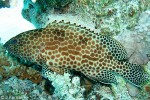Cook Islands Biodiversity Database
Species Page
Epinephelus merra
Pātuki ParuHoneycomb Grouper
Multimedia & Additional Resources
| Type | Description | Download |
| Adult (Aitutaki) | 102KB | |
| Adult (Rarotonga) | 54KB |
General Information
Cook Islands Distribution
| Southern Group: Present Makatea: | ||||||||
RR |
MG |
AT |
MK |
MT |
AK |
PL |
TK |
MN |
P |
P |
^++++ |
P |
|||||
| Northern Group: Present | |||||
TN |
MH |
RK |
PK |
NS |
SW |
P |
P |
P |
|||
Scientific Taxonomy
Epinephelus merra Bloch, 1793
TAXONOMY: ANIMALIA; CHORDATA; GNATHOSTOMATA (Jawed Vertebrates); PISCES; OSTEICHTHYES; Perciformes; Percoidei; Percoidea; SERRANIDAE, Epinephelinae
More Information
GENERAL NOTE: Adults under 16cm SL are all females, and they grow and change into males, the latter averaging 20cmSL. This sex change is called protogynous hermaphroditism, literally female-then-male [Randall 1955].
Vouchers & References
Vouchers:
Rarotonga: BPBM1982. Aitutaki: field-specimen, NBSAP School, 12/2000, ID GM; fieldsight, lagoon, 12/2000, GMcC. Palmerston: NMNZ-P.11460. Tongareva: ANSP86238, 100986; BPBM3791,5643,5647; NMNZ-P.14649. Pukapuka: fieldspecimen+photo, 2/2004, G.McCormack with ID as Epinephelus merra. Suwarrow: field ID Sims (Sims EIA99).
References:
text p.108 Myers (1991 2nd Ed.) Fishes of Micronesia
plate 33e Myers (1991 2nd Ed.) Fishes of Micronesia
p.111 Randall et al. (1990) Fishes of the Great Barrier Reef....
p.186 Burgess et al. (1988) Atlas of Marine Aquarium Fishes (TFH)
plate 28-01 Lieske & Myers (1996) Coral Reef Fishes
plate 23-10 Allen (1997) Marine Fishes of Tropical Australia....
Species No. 491 Munro (1967) Fishes of New Guinea
Data Update History (information):
zTX, zB02, zM02, zupM07a, zD02
Web Resources
Citation Information
McCormack, Gerald (2007) Cook Islands Biodiversity Database, Version 2007.2. Cook Islands Natural Heritage Trust, Rarotonga. Online at http://cookislands.bishopmuseum.org. ![]()
Please refer to our use policy.

